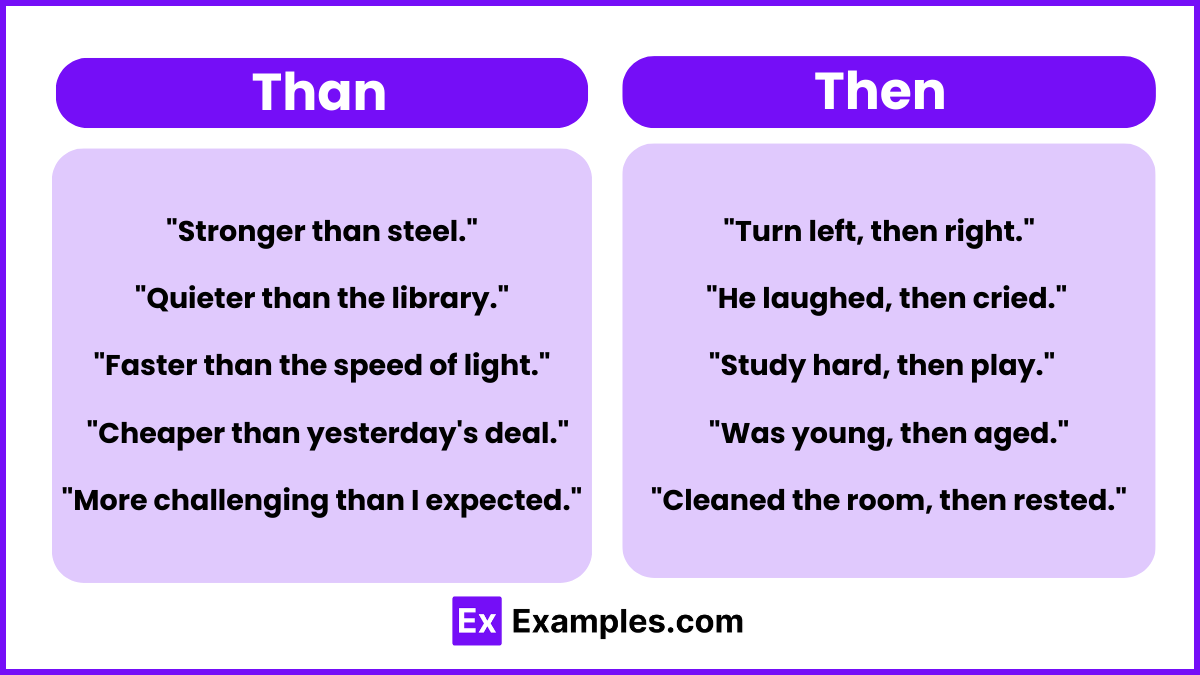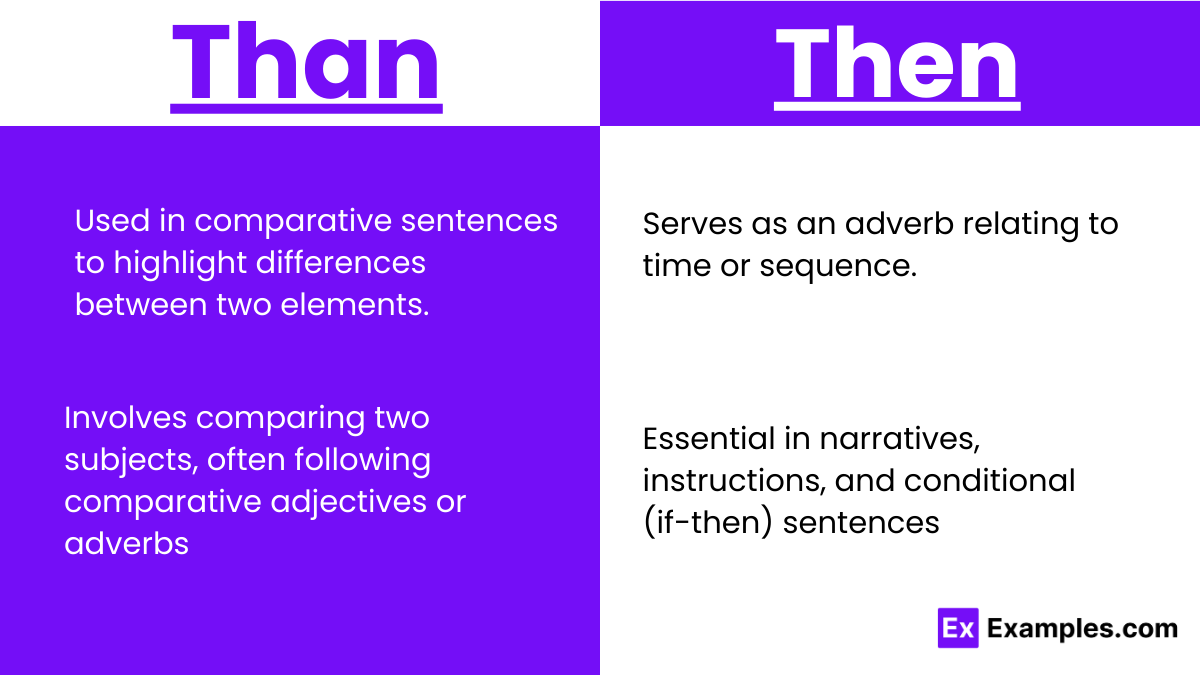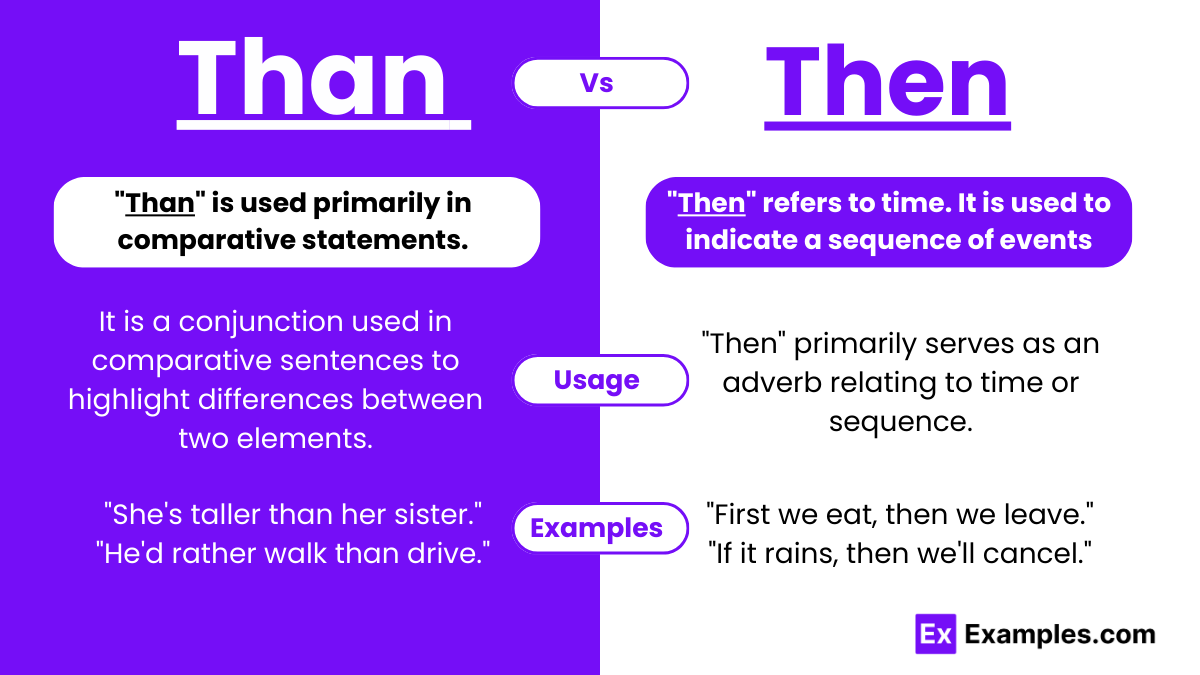Than vs Then – Examples, Differences, Usage
Stepping into the intricate landscape of English grammar, students often find themselves puzzled by the thin line separating “than” and “then.” These two words, while closely linked in spelling, serve entirely different functions within the English language. Aimed at dispelling the confusion, this article provides a clear and concise guide on distinguishing and correctly applying each term. By breaking down their definitions, meanings, and the contexts in which they’re used, we offer students the tools necessary for precise and effective communication. Whether it involves drawing comparisons or outlining sequences of events, understanding the distinction between “than” and “then” is crucial for anyone looking to refine their command of English. Journey with us as we explore these pivotal elements of grammar, ensuring you emerge with the confidence to use “than” and “then” flawlessly in your everyday writing and conversations.
Than and Then – Meanings
“Than” and “Then” are two words that often cause confusion due to their similar spelling but have distinct meanings and uses in the English language.
- Than is used primarily in comparative statements. It functions as a conjunction or preposition to compare two elements, indicating a difference in degree, quantity, or quality between them. For example, “She is taller than her brother,” or “I would rather read than watch TV.”
- Then refers to time. It is used to indicate a sequence of events, showing what happens next or what should be done following something else. For example, “First, we went to the store, and then we went home,” or “If you finish your homework, then you can go outside.”
Understanding the correct usage of “than” and “then” is crucial for clear and precise communication, allowing speakers and writers to convey comparisons and sequences effectively
Summary
“Than” and “Then” are two words with similar spellings that serve distinct purposes in the English language, leading to common confusion among learners. “Than” is utilized mainly for making comparative statements, acting as a conjunction or preposition to highlight differences in degree, quantity, or quality between two elements, as seen in sentences like “She is taller than her brother” or “I would rather read than watch TV.” Conversely, “Then” deals with the aspect of time, indicating the sequence in which events occur or providing direction on what should happen next, exemplified by “First, we went to the store, and then we went home” or “If you finish your homework, then you can go outside.” Grasping the correct applications of “than” and “then” is vital for achieving clear and precise communication, enabling the conveyance of comparisons and sequences with accuracy.
Difference Between Than and Then
| Aspect | Than | Then |
|---|---|---|
| Usage | Used for making comparisons between two elements. | Used to indicate time or sequence of events. |
| Function | Acts as a conjunction or preposition in comparative statements. | Serves as an adverb relating to time, sequence, or consequence. |
| Examples | “She is taller than her brother.” “I would rather read than watch TV.” |
“First, we went to the store, then we went home.” “If you finish your homework, then you can go outside.” |
| Context | Primarily found in sentences that express preference, inequality, or difference. | Often used in narratives, instructions, and conditional statements. |
| Grammar Role | Can function to introduce a dependent clause in comparisons. | Can link two independent clauses to show a cause-and-effect relationship or order. |
| Phonetic Similarity | Despite sounding similar, “than” carries a specific comparative meaning. | “Then” suggests a temporal or logical sequence. |
| Mistake Impact | Misusing “than” can lead to unclear or incorrect comparisons. | Misusing “then” can confuse the order or timing of events |
Examples of Than and Then

Examples of “Than”:
- “She is more interested in science than in history.”
- “This cake is better than the one we had last week.”
- “He can run faster than his brother.”
- “I’d rather go hiking than stay indoors.”
- “It’s more about quality than quantity.”
Examples of “Then”:
- “We went to the movie, and then we grabbed dinner.”
- “If you finish your homework, then you can watch TV.”
- “She was a student then; now, she’s a teacher.”
- “First, preheat the oven; then mix the ingredients.”
- “Back then, we didn’t have smartphones.”
When to Use “Than” and “Then”

Usage of “Than”
- “Than” is a conjunction used in comparative sentences to highlight differences between two elements. It is pivotal in sentences where the focus is on contrasting qualities, quantities, degrees, or values.
- The structure typically involves comparing two subjects, often following comparative adjectives or adverbs (e.g., bigger, more, less, better). For example, in the sentence “She is taller than I am,” “than” is used to compare the height of two individuals. Similarly, “I would prefer to read than watch television” expresses a preference, comparing two activities.
- The use of “than” is strictly for making comparisons, and its correct application is crucial for conveying clear and accurate contrasts in English.
Usage of “Then”
- “Then” primarily serves as an adverb relating to time or sequence. It indicates what happens next in a series of events or the subsequent action in a process.
- “Then” is essential in narratives, instructions, and conditional (if-then) sentences, helping to clarify the order or timing of events. For instance, “We went to the market, and then we cooked dinner,” uses “then” to sequence the events.
- In conditional statements, such as “If you study hard, then you will pass the exams,” “then” introduces the consequence or result of the condition being met. Beyond its temporal use, “then” can also imply a logical conclusion, as in “If that’s true, then we must reconsider our plan.” The correct use of “then” ensures that the listener or reader understands the sequence or relationship between different parts of the discourse.
Each word, “than” and “then,” occupies a unique niche in English grammar and vocabulary. Recognizing and respecting these differences allows for more precise and effective communication, whether in writing or speech. By mastering the use of “than” for comparisons and “then” for sequencing, speakers and writers can express themselves more clearly and accurately, avoiding confusion and misinterpretation
How to Remember the Difference Between Then and Than
Remembering the difference between “then” and “than” can be simplified with a couple of mnemonic devices or simple rules:
- Associate “Then” with Time: Both “then” and “time” start with the letter “T.” If the context involves time or sequence, use “then.” For example, “We went to the cinema, and then we had dinner.”
- Link “Than” with Comparison: “Than” is used for comparison, and both words have the letter “A” in them. Whenever you’re comparing two things, people, actions, or qualities, “than” is the correct choice. For instance, “He is taller than I.”
By associating these keywords with their functions, you can more easily recall which to use in different contexts.
Exceptions
In the English language, “than” and “then” generally adhere to the clear rules of comparison and sequence, respectively. However, the perceived exceptions often stem from misunderstandings or misuses rather than actual grammatical exceptions. Here are some insights regarding the use of “than” and “then” that may seem like exceptions but are actually based on their core definitions:
- Subjunctive Mood with “Than”: At times, “than” is used in sentences that compare hypothetical situations or outcomes, especially with verbs that are in the subjunctive mood. For instance, “I would rather be a bird than be a fish.” While this usage fits the comparative nature of “than,” it might seem exceptional because it deals with unreal, hypothetical scenarios.
- Elliptical Constructions: In some sentences, especially in informal speech or writing, parts of the sentence following “than” may be omitted if they are understood from context. This can make it seem like “than” is being used in an unusual way. For example, “She runs faster than I (do).” The verb “do” is often omitted but understood.
- Sequential Actions Misinterpreted: Sometimes, “then” is used in ways that might initially seem to blur the lines with “than,” especially in casual or spoken English where sequences of actions are compressed. For instance, “Go to the store, then the bank.” While this is a sequence, there’s no comparison, so it’s not an exception but a direct application of “then” for indicating order.
- Poetic or Old English Uses: In poetry, literature, or archaic uses, you might encounter “then” or “than” in contexts that don’t align perfectly with modern usage rules. These are stylistic choices rather than grammatical exceptions. For example, old texts might use “then” in places where contemporary English would strictly use “than” for comparisons, but these are rare and generally understood as archaic.
Common Phrases Using Than and Then
Phrases with “Than”:
- Better late than never: Emphasizes that completing a task late is better than not doing it at all.
- More often than not: Means something happens more times than it does not, indicating frequency.
- Easier said than done: Acknowledges that talking about an action is simpler than actually doing it.
- Other than: Used to indicate an exception or exclusion.
Phrases with “Then”:
- Back then: Refers to a specific period in the past.
- Every now and then: Means occasionally; not very often.
- If…then…: A conditional statement that links an action or condition to its consequence.
- Since then: Indicates the period from a past time to the present.
Understanding these common phrases and their contexts can help solidify the distinction between “then” and “than.” By familiarizing yourself with these expressions and the rules for their use, you’ll be better equipped to use “then” and “than” correctly in your writing and speech, enhancing both clarity and precision in communication.
Is it “better then” or “better then”?
It’s “better than.” “Than” is used for comparisons. For example, “This book is better than the last one I read.”
What is an example of “rather than” or “then”?
The correct phrase is “rather than,” used for preference. For example, “I would rather walk than drive in this weather.”
What are the grammar rules for “then”?
“Then” is used to indicate time or sequence. It’s employed in narratives, instructions, or after “if” in conditional sentences, like “If you study hard, then you will pass.”
Is it “faster than” or “faster then”?
The correct form is “faster than,” which is used for making comparisons. For example, “She runs faster than I do.”



